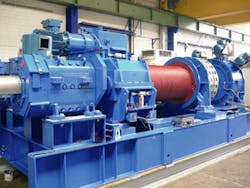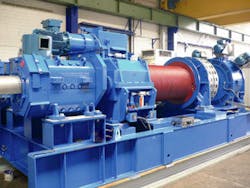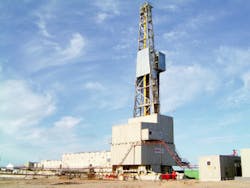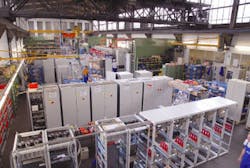A German engineering and fabrication firm has designed new AC drawworks suitable for Arctic drilling conditions.
Bentec GMBH Drilling & Oilfield Systems, based in Bad Bentheim, finished the prototype in June and will send the first four sets of drawworks to western Siberia in second-half 2006 and early 2007, incorporated into cluster slider rigs for TMK-BP Ltd.
Bentec has 270 employees and produces about 10 drilling rigs and other equipment each year. Originally part of a company founded in 1888, which was renamed Deutsche Tiefbohr AG -Deutag-in 1919, and taken over by the Preussag Group in 1990, Bentec became a separate subsidiary in 1993-94. In 2001, Aberdeen-based Abbot Group PLC took over both Bentec and KCA Deutag (OGJ Online, Aug. 31, 2001).
Bentec’s core business is designing and fabricating built-for-purpose drilling and workover rigs, but it also supplies engineering and logistical services, repairs, and piecemeal mechanical and electrical systems.
The company has a history of customizing rigs in many different countries, particularly for the desert environments in Libya and Oman, and repairing rigs with a variety of pumps and drawworks.
Beyond its German headquarters, Bentec now maintains offices in Azerbaijan, Kazakhstan, Turkmenistan, Russia, and Oman.
Focus
“The market drives us to land drilling,” Uwe Singer, managing director, told OGJ. Although Bentec specializes in fit-for-purpose land rigs, it has completed platform rigs for the North Sea and the Caspian Sea (CHWO Shell; Brent Charlie; Esso Jotun; Oseberg Sor; AGIP KCO), models of which grace the company headquarters in Bad Bentheim. Bentec has also recently tendered bids for platform rigs in Iran, said Singer.
But platform rig projects have large financial exposures and there is not enough demand to produce them in a serial mode, he said. Too many of the company’s limited engineering resources are required for a large platform rig project.
Sister company KCA Deutag operates 34 platform rigs and 62 land rigs.
New drawworks
Because the drawworks are the heart of any rig, Bentec’s managers take pride in now having their own design. Fig. 1 shows Bentec’s new drawworks in Bad Bentheim that incorporate Bentec-built AC motors without the usual heavy gearbox. There is no hydraulic switching, only air and AC power for the arctic destinations.
All components are European, with the exception of the Wichita air-cooled brakes (from Wichita Clutch, Wichita Falls, Tex., a division of Altra Industrial Motion, Quincy, Mass.). These model 6032 electric brakes are regenerative and electromagnetic. The mechanical brake system is an air-operated triple-disc brake.
Bentec’s microprocessor-controlled feed-off control system (FOCS) automatic driller is included and provides continuous control of several drilling parameters, such as weight-on-bit, rate-of-penetration, torque, and mud-pump pressure.
Bernd Hofste, Bentec’s research and development coordinator and project supervisor, explained that the company conducted a 2-day failure mode effect analysis (FMEA) session on the new drawworks with external experts from industry and Rheinisch-Westfälischen Hochschule (RWTH), Aachen. This theoretical exercise was to build the protocol and produced a CE (Conformité Européenne) mark and Bentec’s required Declaration of Conformity. (The CE mark is the official marking required by the European Community for all electric and electronic equipment that will be sold, or put into service for the first time, anywhere in the European community.)
The new drawworks were tested for 2 weeks, in early July, and released to Rig T-502, the second HR-5000 harsh-environment rig now en route to Russia.
EDRA
For several years, Bentec has been part of the European Drilling Rig Alliance, along with Italy’s Drillmec SPA and Germany’s Wirth GMBH (OGJ, Oct. 17, 2005, p. 42). Drillmec supplied mast and substructures, Wirth supplied drawworks and pumps, and Bentec supplied mechanical and electrical components for the rest of the drilling and mud systems. All three companies exhibited under the EDRA banner at the Offshore Technology Conference in Houston earlier this year.
As part of the Alliance, Bentec sent SCR (silicon-controlled rectifier) units and mud systems to Italy, and Drillmec assembled and shipped four drilling rigs to Algeria in 2005-06.
Russia
Bernd Albrecht, vice-president of marketing and sales, is responsible for all of Bentec’s Russian activities and believes that the company can enhance its position in Russia. Albrecht joined Bentec in January 2006, after heading up TNK-BP’s Moscow office. He told OGJ that working through the logistics for projects in Russia is straightforward and predictable, but that success hinges on managing expectations. The process is slow but transparent, requiring attention to rules and regulations set by Gosstandart, the national standards body and Gosgortechnadzor, the mining authority. The new 1,500-hp cluster slider rigs are being built to Russian GOST standards (Fig. 2).
Albrecht pointed out that API is not a globally mandated standard, although Bentec rigs have been built to meet ISO 9001 and API specifications in the past (OGJ Online, Jan. 15, 2001).
Bentec has a registered office in Kaliningrad, soon to move to Tyumen Oblast, west Siberia, with responsibility for sales and wellsite services. The second Cluster Slider HR-5000, Rig 501, sent to Russia earlier this year, will be used as for training in Tyumen. The company intends to establish a manufacturing facility in Tyumen that would employ 200-300 workers to build 6-8 rigs/year. Bentec has signed letters of intent and is evaluating a construction site.
Construction work on substructures, masts, and tank systems in Tyumen could begin by first-quarter 2008, and the Russian-built Bentec rigs would include “performance-enhanced drilling components from Germany.” Bentec’s focus area is Russia, and the company will “Russianize,” Singer said.
In the meantime, the company is building four more HR-5000 rigs in Germany. The substructures and masts (57 m high) for the T-502 and T-503 were being assembled at the TST yard in Nordhorner, 18 km from Bad Bentheim. Rigs are trucked from Bad Bentheim to the port of Nordenham, about 180 km northwest.
It takes about 2 months to assemble and test all the rig components, disassemble, pack, and label (in Russian) before shipping. The T-503 and T-504 should be finished and shipped by yearend; the fourth rig, T-505 will be delivered in March 2007.
Although the Yekaterinburg-based Uralmash Joint Stock Co. could produce all rigs required for the Russian market, Albrecht said that Uralmash tried to use western-style manufacturing processes in the 1990s that included outsourcing components but found the price point increases unacceptable.
Bentec is positioning a version of the HR-4000 rig as a substitute for the Uralmash BU-3000 rig in the Russian market. Albrecht said the HR-4000 could be built at 15% lower cost than the HR-5000 and could move in 12-15 days, pad-to-pad, while the HR-5000 takes about 40 days pad-to-pad. The all-mechanical Russian BU-3000 rig, in comparison, can drill shallow wells in 10-15 days but requires 45-50 days to move, at best. The Bentec rigs, therefore, provide significant time and cost savings in drilling and rig move time.
Singer said he wants to build hundreds of the HR-4000 rigs, particularly the 250-tonne version, to replace the aging Russian fleet. He said there are about 450 land rigs in Russia with hook load capacity of 175 tonnes or greater, but about 70% of those were at least 15 years old. These aging, mechanical rigs with chain-driven rotary tables and duplex pumps would each cost $7 million to upgrade. Nonproductive time is about 24% with Russian rigs, Singer said, and new or upgraded rigs would be far more efficient.
At the end of 2005, Bentec sent SCR and MCC components for two BU-3900 Uralmash rigs to Salym Petroleum Development, a joint venture between Royal Dutch Shell and OAD Evikhon. The land rigs have a 3,900-m drilling depth capacity. The company plans to send components for a BU-3200 rig at the end of 2006.
There is “a push to increase Russian content,” Singer said. Bentec will manufacture rigs in Russia and will become a Russian company.
Oman
In 2005, Bentec opened a rig service yard in Gahla, an industrial area of Muscat. Juergen Rueggen, Bentec sales manager, told OGJ that the company needed a specialized yard “closer to our customers” to provide repair services and to complete rig upgrades. There are 30-35 rigs working in Oman, but all drilling contractors were sending rigs to Muscat and then on to Dubai for repairs and servicing.
International Drilling Technology Co. LLC (IDTEC) is a joint venture with Omani partner AOTC, operated by Bentec, employing about 20 full-time staff. Although primarily staffed by Omani and Indian nationals, two German maintenance supervisors work on 5-week rotations and the operations manager is Australian.
The new IDTEC yard is open to all drilling contractors and all makes of rigs. The first project involved repairing a 3,000-hp drilling rig, and now the yard is busy with two American workover rigs and performing inspections for certifications.
Training
Bentec has rigorous, 3-year training programs for technicians in electrical and mechanical systems. At this time, there are 17 new electrical trainees and the company adds about 6/year. The mechanical systems program takes on about 3-5 new trainees/year, with 9-15 in the program at any given time.
The training areas (Ausbildungs Werkstatt) at Bad Bentheim are immaculate, housed in brightly lit spacious brick buildings with high windows and ample overhead crane tracks (Fig. 3).
Rueggen said that the company has about 90% retention; only about 10% of the staff leaves after training. Most begin with the company immediately following secondary school (16-17 years old); several move on to complete university studies after the training and return to Bentec as engineers.
Sister company KCA Deutag offers the complementary DART program-Deutag Advanced Rig Training-in Aberdeen.
After working in Libya since 1958, KCAD established a new training facility in Tripoli, which graduated its first class in April 2006. Surprisingly, 90% of the Libyan graduates left the company, a proportion opposite that of German-trained candidates.
KCAD has four companies to consolidate in Libya, including its recent acquisition of Tripoli-based ILI Corp.
Future
Singer said that Bentec envisions a triangular marketing format, based on repair and certification work in the Middle East; serial rig production in Russia; and specialized, purpose-built rig design and fabrication in Bad Bentheim. We want to “stay in our market segments and maintain margins,” he said, and try to expand the business areas.
The company is looking for an additional yard in the Middle East to perform additional assembly, repair, service, and certification work.
Bentec will probably never produce off-the-shelf, 1,500-hp rigs for the Middle East, Singer said. There is more competition there from Chinese manufacturers, which can turn out hundreds of rigs each year. However, Bentec is presently building two 1,500-hp “Nomad” rigs for a customer.
To be successful, Bentec needs to leverage its expertise and produce increasingly sophisticated products that incorporate new technologies. One of the company’s business philosophies is to outsource low-value work and increase capacity for high-value work.
Another possible strategic change would be to concentrate on high-value components rather than producing complete rigs in-house.
In the Abbot Group’s 2005 annual report, executive chairman Alastair Locke said the company “will continue to make investments in land drilling units” as Bentec will “provide the capacity for new builds. This is a major advantage...given that a number of major suppliers or rigs and rig equipment” are capacity constrained. Regional offices will also give the group “access to more projects...to modernize the rig fleet.”
Recent projects
Major projects for Bentec in 2004-06 include:
- Building five mobile AE 520 rigs for Joint Stock Co. PZTM, Petropawlowsk, Kazakhstan (OGJ, Sept. 20, 2004, p. 35).
- Fabricating the 2,500-hp T-150 rig for the Mittelplate drilling and production island in the German North Sea, for RWE Dea AG (operator) and Wintershall AG (OGJ, June 20, 2005, p. 49).
- Supplying SCR units, generator sets, tank systems and equipment for four land drilling rigs for Entreprise Nationale des Travaux aux Puits (ENTP), Hassi Messaoud, Algeria; and for another four land rigs for National Iranian Drilling Co. (NIDC).
- Designing and fabricating two 1,500-hp HR-5000 drilling rig packages for Arctic cluster drilling in Russia. The rigs were built for KCA Deutag’s contract work with TNK-BP Ltd. in Tyumen Oblast, western Siberia (OGJ, Oct. 17, 2005, p. 42).
- Fabricating a 1,500-hp, 350-tonne AC land rig for KCA Deutag’s use in Europe under a contract with OMV Austria Exploration and Production GMBH. This low-emission, quiet, highly mobile rig, T-208, has a small footprint and is the first Bentec rig to meet the new European electrical ATEX standards. It spud the first well on May 29, 2006, in the Vienna basin, 40 km north of Vienna. KCAD commissioned a film detailing the construction, move, and rig-up.
- Designing, building, and testing new AC drawworks to replace Wirth GMBH drawworks in future Bentec rigs.
- Building four additional cluster slider drilling rigs for TNK-BP, incorporating the new Bentec drawworks (OGJ, Feb. 13, 2006, p. 43).



